Project Management Report: DSDM, Team Structures, and Qualities
VerifiedAdded on 2020/02/03
|17
|4721
|38
Report
AI Summary
This report delves into the core concepts of project management, exploring the seven phases of Dynamic System Development Method (DSDM) and its nine principles. It analyzes different project team structures, including functional, matrix, and project-based teams, highlighting their respective strengths and weaknesses. The report also examines the qualities essential for a successful project manager, such as vision, communication, integrity, and delegation. Furthermore, it addresses the difficulties project managers face in controlling IT projects, including technical failures, unrealistic deadlines, and the challenges of managing project mandates. Finally, the report outlines strategies for building effective project teams and navigating the complexities of project execution, emphasizing the importance of clear communication, resource management, and proactive risk mitigation.
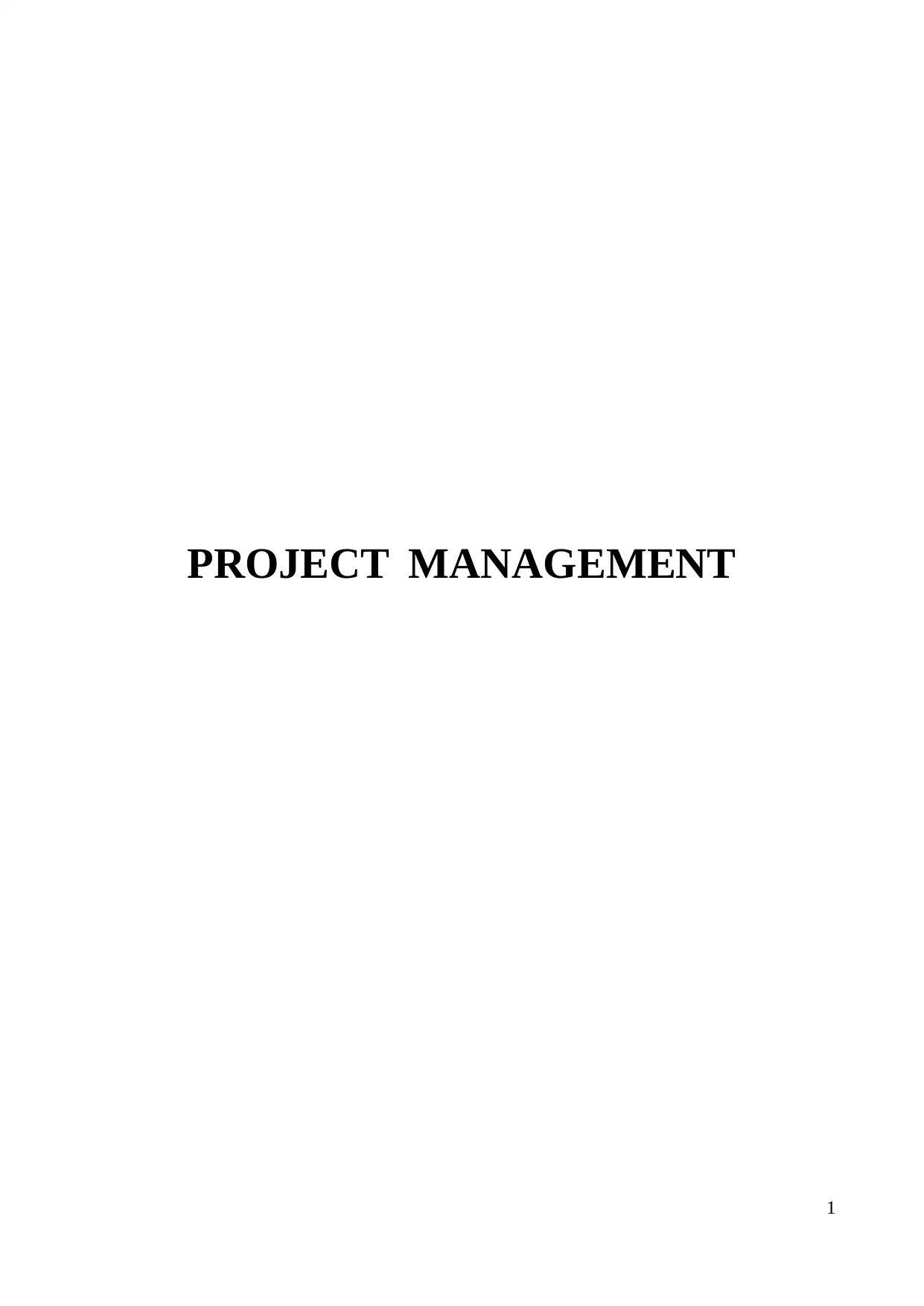
PROJECT MANAGEMENT
1
1
Paraphrase This Document
Need a fresh take? Get an instant paraphrase of this document with our AI Paraphraser
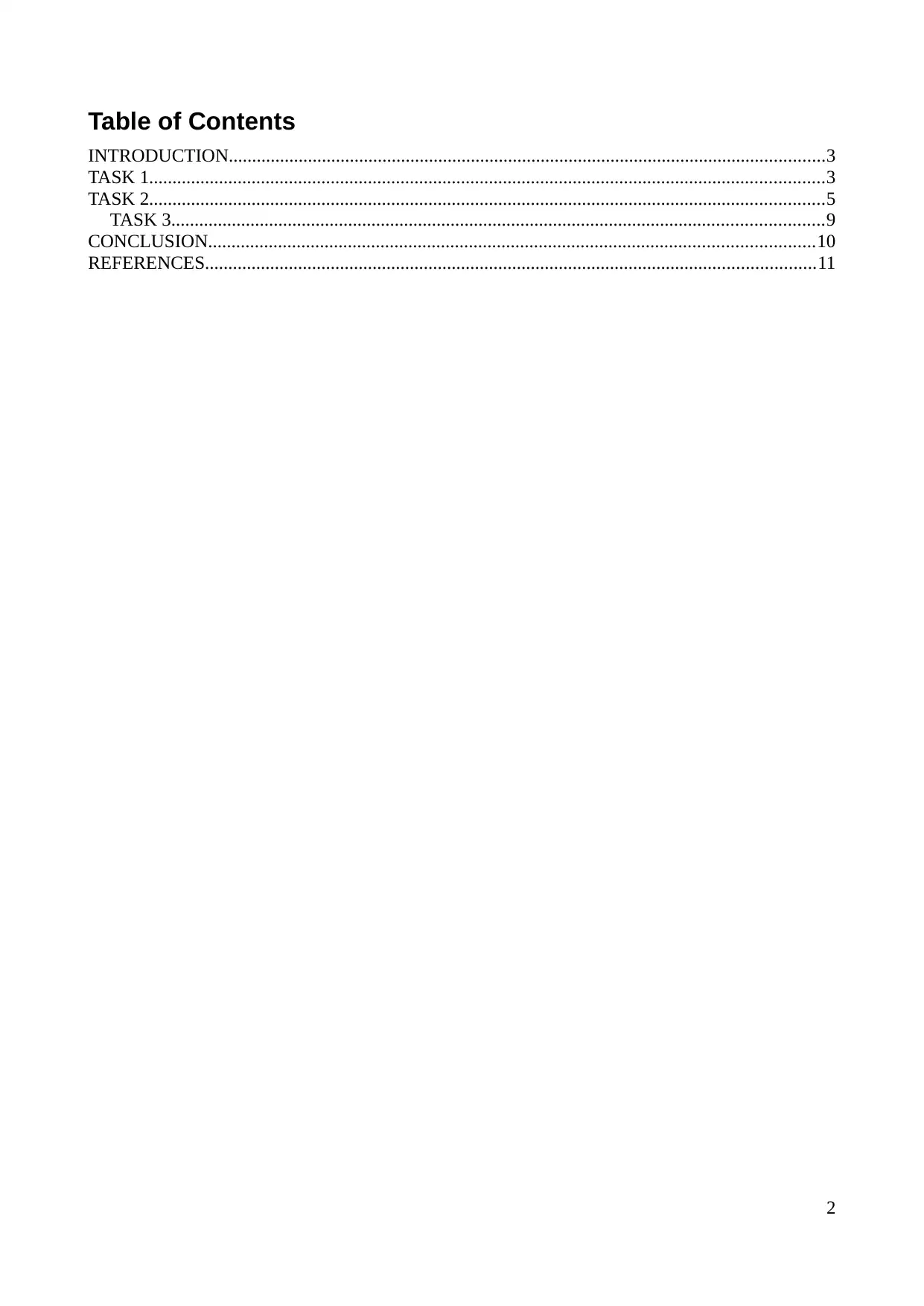
Table of Contents
INTRODUCTION................................................................................................................................3
TASK 1.................................................................................................................................................3
TASK 2.................................................................................................................................................5
TASK 3............................................................................................................................................9
CONCLUSION..................................................................................................................................10
REFERENCES...................................................................................................................................11
2
INTRODUCTION................................................................................................................................3
TASK 1.................................................................................................................................................3
TASK 2.................................................................................................................................................5
TASK 3............................................................................................................................................9
CONCLUSION..................................................................................................................................10
REFERENCES...................................................................................................................................11
2
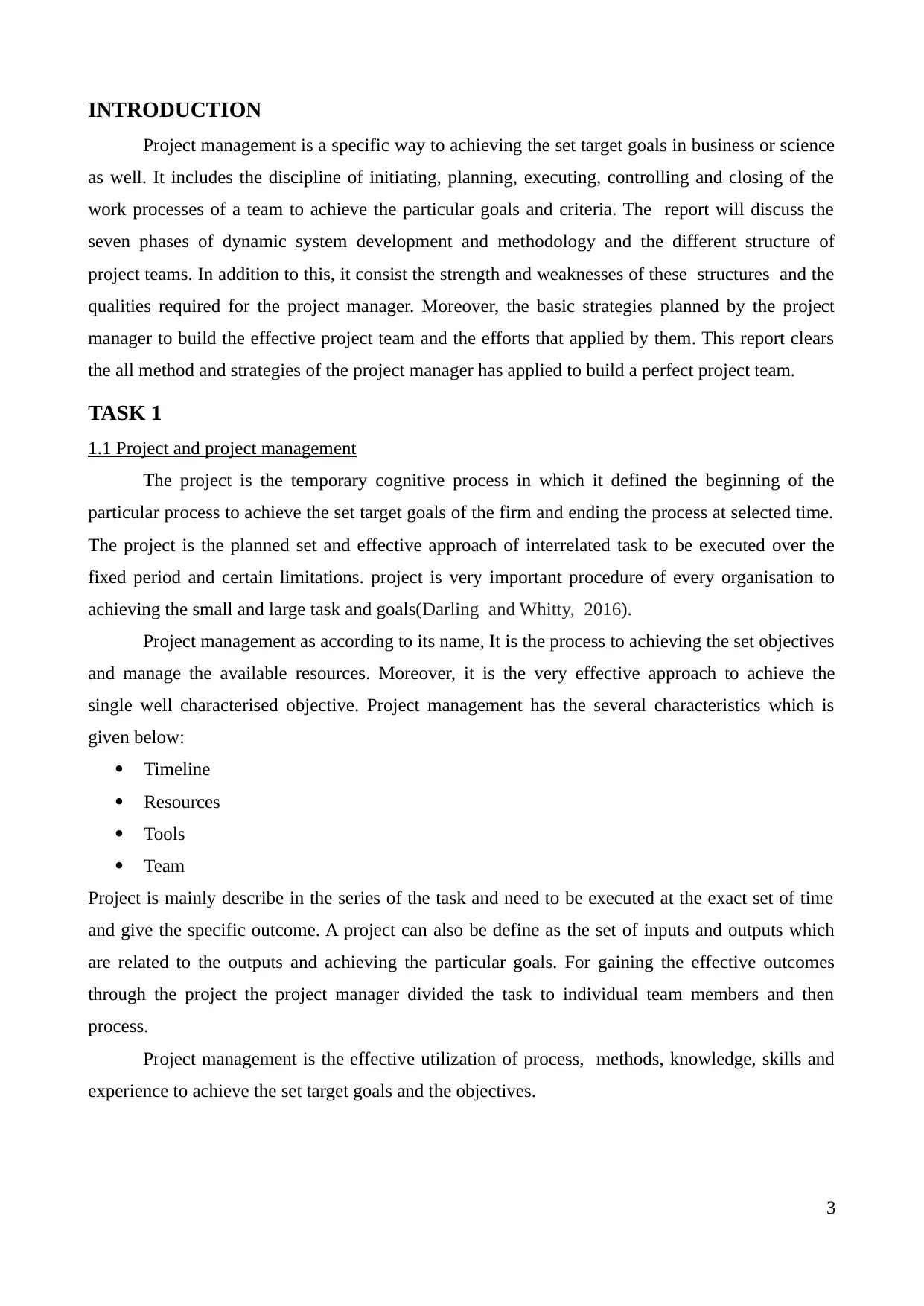
INTRODUCTION
Project management is a specific way to achieving the set target goals in business or science
as well. It includes the discipline of initiating, planning, executing, controlling and closing of the
work processes of a team to achieve the particular goals and criteria. The report will discuss the
seven phases of dynamic system development and methodology and the different structure of
project teams. In addition to this, it consist the strength and weaknesses of these structures and the
qualities required for the project manager. Moreover, the basic strategies planned by the project
manager to build the effective project team and the efforts that applied by them. This report clears
the all method and strategies of the project manager has applied to build a perfect project team.
TASK 1
1.1 Project and project management
The project is the temporary cognitive process in which it defined the beginning of the
particular process to achieve the set target goals of the firm and ending the process at selected time.
The project is the planned set and effective approach of interrelated task to be executed over the
fixed period and certain limitations. project is very important procedure of every organisation to
achieving the small and large task and goals(Darling and Whitty, 2016).
Project management as according to its name, It is the process to achieving the set objectives
and manage the available resources. Moreover, it is the very effective approach to achieve the
single well characterised objective. Project management has the several characteristics which is
given below:
Timeline
Resources
Tools
Team
Project is mainly describe in the series of the task and need to be executed at the exact set of time
and give the specific outcome. A project can also be define as the set of inputs and outputs which
are related to the outputs and achieving the particular goals. For gaining the effective outcomes
through the project the project manager divided the task to individual team members and then
process.
Project management is the effective utilization of process, methods, knowledge, skills and
experience to achieve the set target goals and the objectives.
3
Project management is a specific way to achieving the set target goals in business or science
as well. It includes the discipline of initiating, planning, executing, controlling and closing of the
work processes of a team to achieve the particular goals and criteria. The report will discuss the
seven phases of dynamic system development and methodology and the different structure of
project teams. In addition to this, it consist the strength and weaknesses of these structures and the
qualities required for the project manager. Moreover, the basic strategies planned by the project
manager to build the effective project team and the efforts that applied by them. This report clears
the all method and strategies of the project manager has applied to build a perfect project team.
TASK 1
1.1 Project and project management
The project is the temporary cognitive process in which it defined the beginning of the
particular process to achieve the set target goals of the firm and ending the process at selected time.
The project is the planned set and effective approach of interrelated task to be executed over the
fixed period and certain limitations. project is very important procedure of every organisation to
achieving the small and large task and goals(Darling and Whitty, 2016).
Project management as according to its name, It is the process to achieving the set objectives
and manage the available resources. Moreover, it is the very effective approach to achieve the
single well characterised objective. Project management has the several characteristics which is
given below:
Timeline
Resources
Tools
Team
Project is mainly describe in the series of the task and need to be executed at the exact set of time
and give the specific outcome. A project can also be define as the set of inputs and outputs which
are related to the outputs and achieving the particular goals. For gaining the effective outcomes
through the project the project manager divided the task to individual team members and then
process.
Project management is the effective utilization of process, methods, knowledge, skills and
experience to achieve the set target goals and the objectives.
3
⊘ This is a preview!⊘
Do you want full access?
Subscribe today to unlock all pages.

Trusted by 1+ million students worldwide

1.2 Criteria of the project is successful or not
Project manager has mainly focuses on the successful achievement of the project goals and
set targets. A project success criteria mainly begin with the initiatives which are taken by the
manger and followed by the whole project team. Successful project mainly depends on the
customer's feedback in which the project manager definitely ask their customer about the feedback.
This is the effective approach to prove the project is successful or not and what are the
improvement needed for the project to be successful. Further discuss the project success criteria
which is given below:
Negotiations
Proper and conducive project plan
Assigns the specific tasks to their project team members
Perfect strategies make for achieving the common tasks
Manage the project risks efficiently
1.3 Seven phases of DSDM and the nine principles of DSDM framework
The dynamic development system and methodology is having the several phases and it is the
framework for developing the software way and clearly defines the role, phases, sub-phases and the
principles. Mainly DSDM includes the 3 framework as pre-project, life cycle, post project and these
are further divided into 4 phases of the project status.
Pre-project
Feasibility
Foundations
Exploration and engineering
Development
Post project
There are nine principles of the DSDM which are given below:
The teams are must be empowered to make the clear and cut decision
Mainly focuses on the frequent delivery
Incremental development
Collaborative and co-operative approach
Requirements are the base for the project management
Effective involvement of user
Life cycle testing is integrated
4
Project manager has mainly focuses on the successful achievement of the project goals and
set targets. A project success criteria mainly begin with the initiatives which are taken by the
manger and followed by the whole project team. Successful project mainly depends on the
customer's feedback in which the project manager definitely ask their customer about the feedback.
This is the effective approach to prove the project is successful or not and what are the
improvement needed for the project to be successful. Further discuss the project success criteria
which is given below:
Negotiations
Proper and conducive project plan
Assigns the specific tasks to their project team members
Perfect strategies make for achieving the common tasks
Manage the project risks efficiently
1.3 Seven phases of DSDM and the nine principles of DSDM framework
The dynamic development system and methodology is having the several phases and it is the
framework for developing the software way and clearly defines the role, phases, sub-phases and the
principles. Mainly DSDM includes the 3 framework as pre-project, life cycle, post project and these
are further divided into 4 phases of the project status.
Pre-project
Feasibility
Foundations
Exploration and engineering
Development
Post project
There are nine principles of the DSDM which are given below:
The teams are must be empowered to make the clear and cut decision
Mainly focuses on the frequent delivery
Incremental development
Collaborative and co-operative approach
Requirements are the base for the project management
Effective involvement of user
Life cycle testing is integrated
4
Paraphrase This Document
Need a fresh take? Get an instant paraphrase of this document with our AI Paraphraser
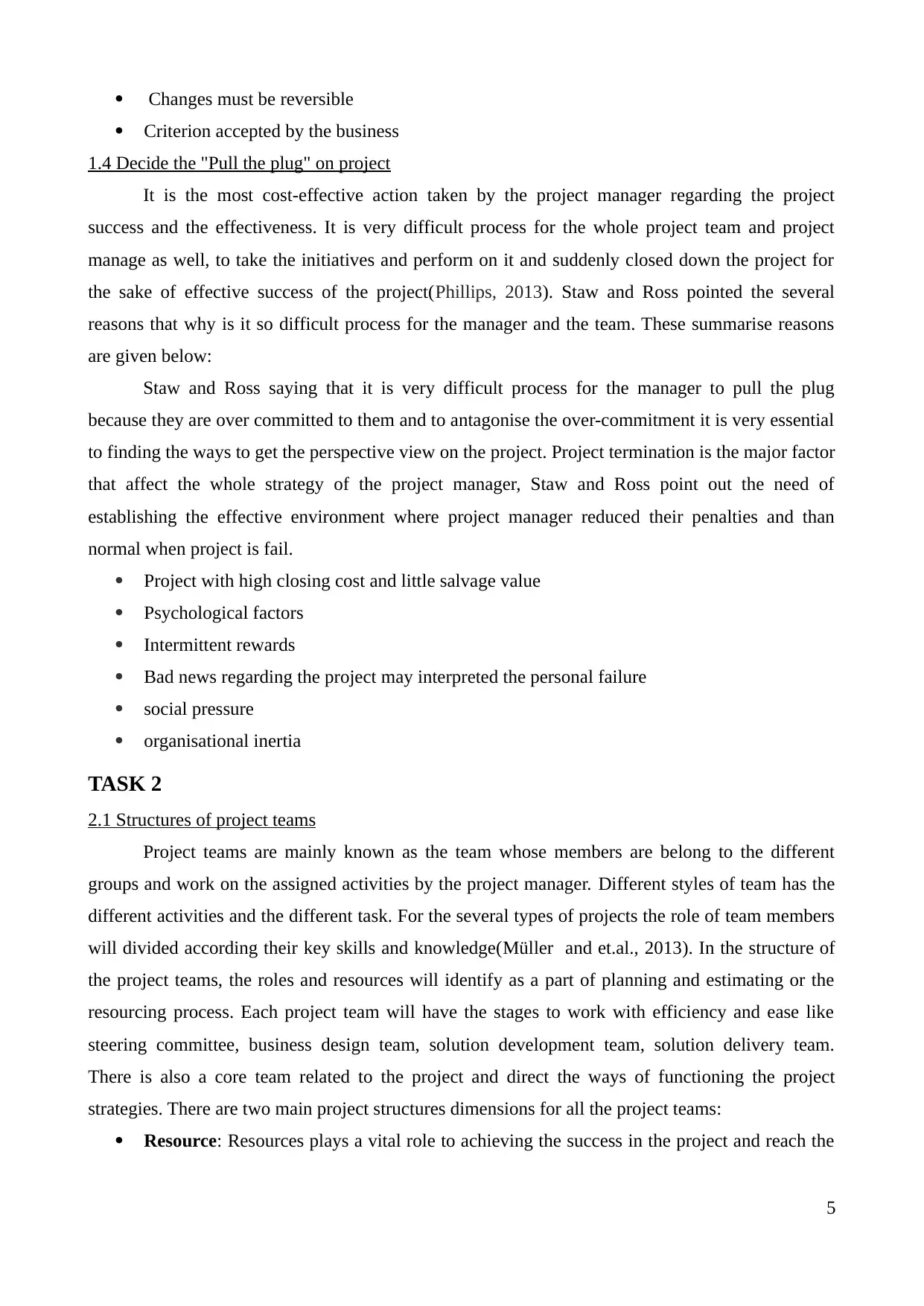
Changes must be reversible
Criterion accepted by the business
1.4 Decide the "Pull the plug" on project
It is the most cost-effective action taken by the project manager regarding the project
success and the effectiveness. It is very difficult process for the whole project team and project
manage as well, to take the initiatives and perform on it and suddenly closed down the project for
the sake of effective success of the project(Phillips, 2013). Staw and Ross pointed the several
reasons that why is it so difficult process for the manager and the team. These summarise reasons
are given below:
Staw and Ross saying that it is very difficult process for the manager to pull the plug
because they are over committed to them and to antagonise the over-commitment it is very essential
to finding the ways to get the perspective view on the project. Project termination is the major factor
that affect the whole strategy of the project manager, Staw and Ross point out the need of
establishing the effective environment where project manager reduced their penalties and than
normal when project is fail.
Project with high closing cost and little salvage value
Psychological factors
Intermittent rewards
Bad news regarding the project may interpreted the personal failure
social pressure
organisational inertia
TASK 2
2.1 Structures of project teams
Project teams are mainly known as the team whose members are belong to the different
groups and work on the assigned activities by the project manager. Different styles of team has the
different activities and the different task. For the several types of projects the role of team members
will divided according their key skills and knowledge(Müller and et.al., 2013). In the structure of
the project teams, the roles and resources will identify as a part of planning and estimating or the
resourcing process. Each project team will have the stages to work with efficiency and ease like
steering committee, business design team, solution development team, solution delivery team.
There is also a core team related to the project and direct the ways of functioning the project
strategies. There are two main project structures dimensions for all the project teams:
Resource: Resources plays a vital role to achieving the success in the project and reach the
5
Criterion accepted by the business
1.4 Decide the "Pull the plug" on project
It is the most cost-effective action taken by the project manager regarding the project
success and the effectiveness. It is very difficult process for the whole project team and project
manage as well, to take the initiatives and perform on it and suddenly closed down the project for
the sake of effective success of the project(Phillips, 2013). Staw and Ross pointed the several
reasons that why is it so difficult process for the manager and the team. These summarise reasons
are given below:
Staw and Ross saying that it is very difficult process for the manager to pull the plug
because they are over committed to them and to antagonise the over-commitment it is very essential
to finding the ways to get the perspective view on the project. Project termination is the major factor
that affect the whole strategy of the project manager, Staw and Ross point out the need of
establishing the effective environment where project manager reduced their penalties and than
normal when project is fail.
Project with high closing cost and little salvage value
Psychological factors
Intermittent rewards
Bad news regarding the project may interpreted the personal failure
social pressure
organisational inertia
TASK 2
2.1 Structures of project teams
Project teams are mainly known as the team whose members are belong to the different
groups and work on the assigned activities by the project manager. Different styles of team has the
different activities and the different task. For the several types of projects the role of team members
will divided according their key skills and knowledge(Müller and et.al., 2013). In the structure of
the project teams, the roles and resources will identify as a part of planning and estimating or the
resourcing process. Each project team will have the stages to work with efficiency and ease like
steering committee, business design team, solution development team, solution delivery team.
There is also a core team related to the project and direct the ways of functioning the project
strategies. There are two main project structures dimensions for all the project teams:
Resource: Resources plays a vital role to achieving the success in the project and reach the
5
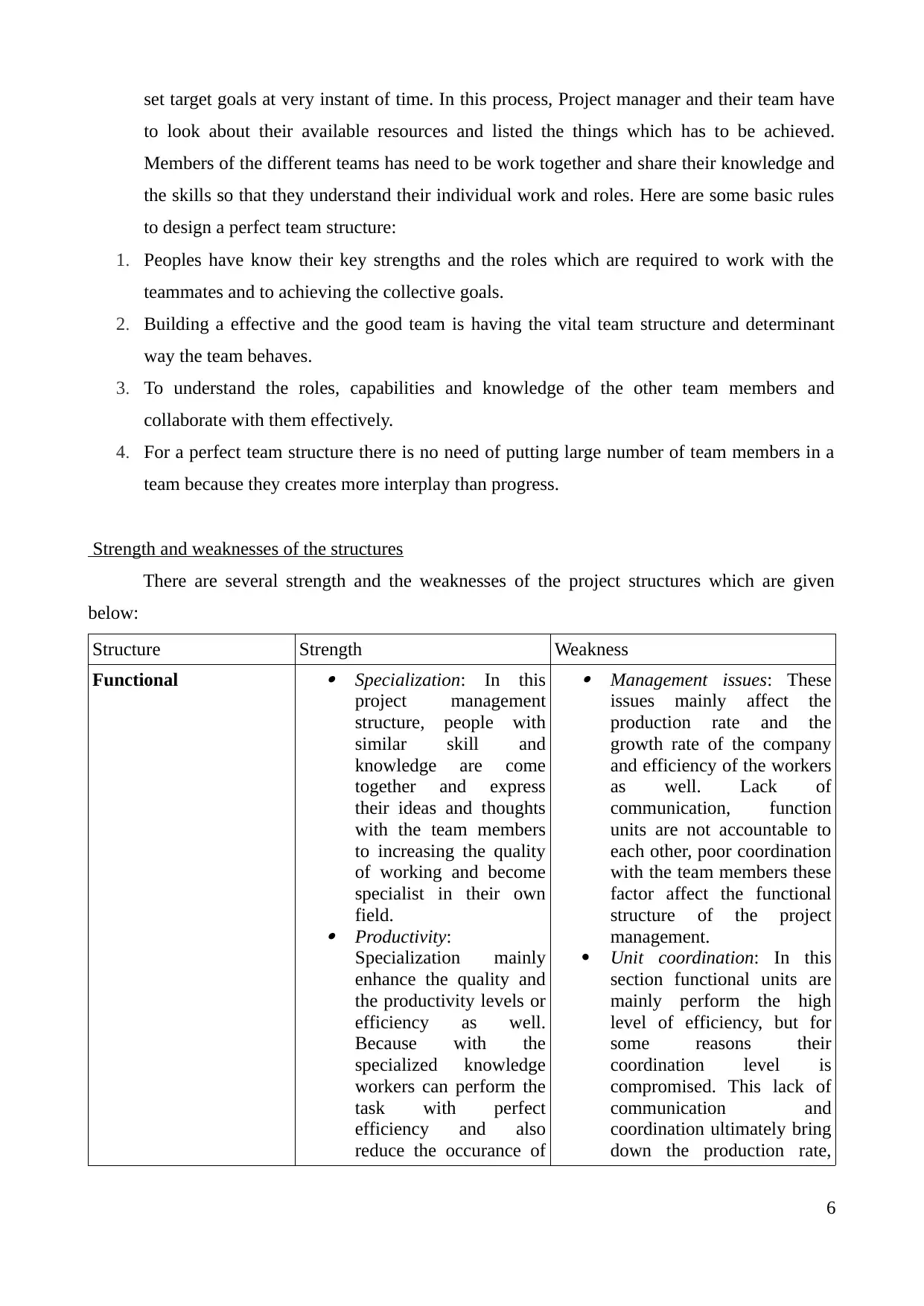
set target goals at very instant of time. In this process, Project manager and their team have
to look about their available resources and listed the things which has to be achieved.
Members of the different teams has need to be work together and share their knowledge and
the skills so that they understand their individual work and roles. Here are some basic rules
to design a perfect team structure:
1. Peoples have know their key strengths and the roles which are required to work with the
teammates and to achieving the collective goals.
2. Building a effective and the good team is having the vital team structure and determinant
way the team behaves.
3. To understand the roles, capabilities and knowledge of the other team members and
collaborate with them effectively.
4. For a perfect team structure there is no need of putting large number of team members in a
team because they creates more interplay than progress.
Strength and weaknesses of the structures
There are several strength and the weaknesses of the project structures which are given
below:
Structure Strength Weakness
Functional
Specialization: In this
project management
structure, people with
similar skill and
knowledge are come
together and express
their ideas and thoughts
with the team members
to increasing the quality
of working and become
specialist in their own
field.
Productivity:
Specialization mainly
enhance the quality and
the productivity levels or
efficiency as well.
Because with the
specialized knowledge
workers can perform the
task with perfect
efficiency and also
reduce the occurance of
Management issues: These
issues mainly affect the
production rate and the
growth rate of the company
and efficiency of the workers
as well. Lack of
communication, function
units are not accountable to
each other, poor coordination
with the team members these
factor affect the functional
structure of the project
management.
Unit coordination: In this
section functional units are
mainly perform the high
level of efficiency, but for
some reasons their
coordination level is
compromised. This lack of
communication and
coordination ultimately bring
down the production rate,
6
to look about their available resources and listed the things which has to be achieved.
Members of the different teams has need to be work together and share their knowledge and
the skills so that they understand their individual work and roles. Here are some basic rules
to design a perfect team structure:
1. Peoples have know their key strengths and the roles which are required to work with the
teammates and to achieving the collective goals.
2. Building a effective and the good team is having the vital team structure and determinant
way the team behaves.
3. To understand the roles, capabilities and knowledge of the other team members and
collaborate with them effectively.
4. For a perfect team structure there is no need of putting large number of team members in a
team because they creates more interplay than progress.
Strength and weaknesses of the structures
There are several strength and the weaknesses of the project structures which are given
below:
Structure Strength Weakness
Functional
Specialization: In this
project management
structure, people with
similar skill and
knowledge are come
together and express
their ideas and thoughts
with the team members
to increasing the quality
of working and become
specialist in their own
field.
Productivity:
Specialization mainly
enhance the quality and
the productivity levels or
efficiency as well.
Because with the
specialized knowledge
workers can perform the
task with perfect
efficiency and also
reduce the occurance of
Management issues: These
issues mainly affect the
production rate and the
growth rate of the company
and efficiency of the workers
as well. Lack of
communication, function
units are not accountable to
each other, poor coordination
with the team members these
factor affect the functional
structure of the project
management.
Unit coordination: In this
section functional units are
mainly perform the high
level of efficiency, but for
some reasons their
coordination level is
compromised. This lack of
communication and
coordination ultimately bring
down the production rate,
6
⊘ This is a preview!⊘
Do you want full access?
Subscribe today to unlock all pages.

Trusted by 1+ million students worldwide
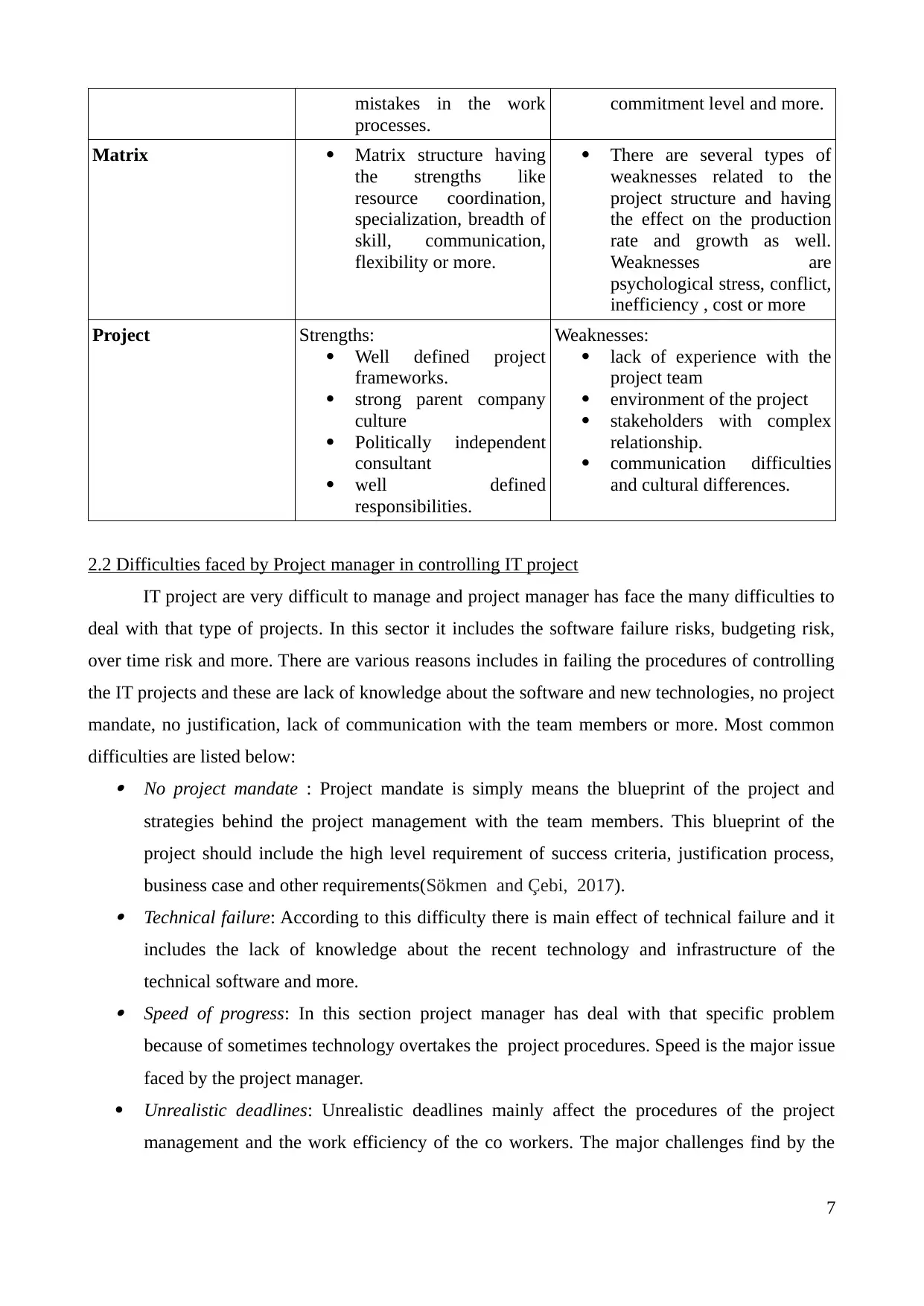
mistakes in the work
processes.
commitment level and more.
Matrix Matrix structure having
the strengths like
resource coordination,
specialization, breadth of
skill, communication,
flexibility or more.
There are several types of
weaknesses related to the
project structure and having
the effect on the production
rate and growth as well.
Weaknesses are
psychological stress, conflict,
inefficiency , cost or more
Project Strengths:
Well defined project
frameworks.
strong parent company
culture
Politically independent
consultant
well defined
responsibilities.
Weaknesses:
lack of experience with the
project team
environment of the project
stakeholders with complex
relationship.
communication difficulties
and cultural differences.
2.2 Difficulties faced by Project manager in controlling IT project
IT project are very difficult to manage and project manager has face the many difficulties to
deal with that type of projects. In this sector it includes the software failure risks, budgeting risk,
over time risk and more. There are various reasons includes in failing the procedures of controlling
the IT projects and these are lack of knowledge about the software and new technologies, no project
mandate, no justification, lack of communication with the team members or more. Most common
difficulties are listed below: No project mandate : Project mandate is simply means the blueprint of the project and
strategies behind the project management with the team members. This blueprint of the
project should include the high level requirement of success criteria, justification process,
business case and other requirements(Sökmen and Çebi, 2017). Technical failure: According to this difficulty there is main effect of technical failure and it
includes the lack of knowledge about the recent technology and infrastructure of the
technical software and more. Speed of progress: In this section project manager has deal with that specific problem
because of sometimes technology overtakes the project procedures. Speed is the major issue
faced by the project manager.
Unrealistic deadlines: Unrealistic deadlines mainly affect the procedures of the project
management and the work efficiency of the co workers. The major challenges find by the
7
processes.
commitment level and more.
Matrix Matrix structure having
the strengths like
resource coordination,
specialization, breadth of
skill, communication,
flexibility or more.
There are several types of
weaknesses related to the
project structure and having
the effect on the production
rate and growth as well.
Weaknesses are
psychological stress, conflict,
inefficiency , cost or more
Project Strengths:
Well defined project
frameworks.
strong parent company
culture
Politically independent
consultant
well defined
responsibilities.
Weaknesses:
lack of experience with the
project team
environment of the project
stakeholders with complex
relationship.
communication difficulties
and cultural differences.
2.2 Difficulties faced by Project manager in controlling IT project
IT project are very difficult to manage and project manager has face the many difficulties to
deal with that type of projects. In this sector it includes the software failure risks, budgeting risk,
over time risk and more. There are various reasons includes in failing the procedures of controlling
the IT projects and these are lack of knowledge about the software and new technologies, no project
mandate, no justification, lack of communication with the team members or more. Most common
difficulties are listed below: No project mandate : Project mandate is simply means the blueprint of the project and
strategies behind the project management with the team members. This blueprint of the
project should include the high level requirement of success criteria, justification process,
business case and other requirements(Sökmen and Çebi, 2017). Technical failure: According to this difficulty there is main effect of technical failure and it
includes the lack of knowledge about the recent technology and infrastructure of the
technical software and more. Speed of progress: In this section project manager has deal with that specific problem
because of sometimes technology overtakes the project procedures. Speed is the major issue
faced by the project manager.
Unrealistic deadlines: Unrealistic deadlines mainly affect the procedures of the project
management and the work efficiency of the co workers. The major challenges find by the
7
Paraphrase This Document
Need a fresh take? Get an instant paraphrase of this document with our AI Paraphraser
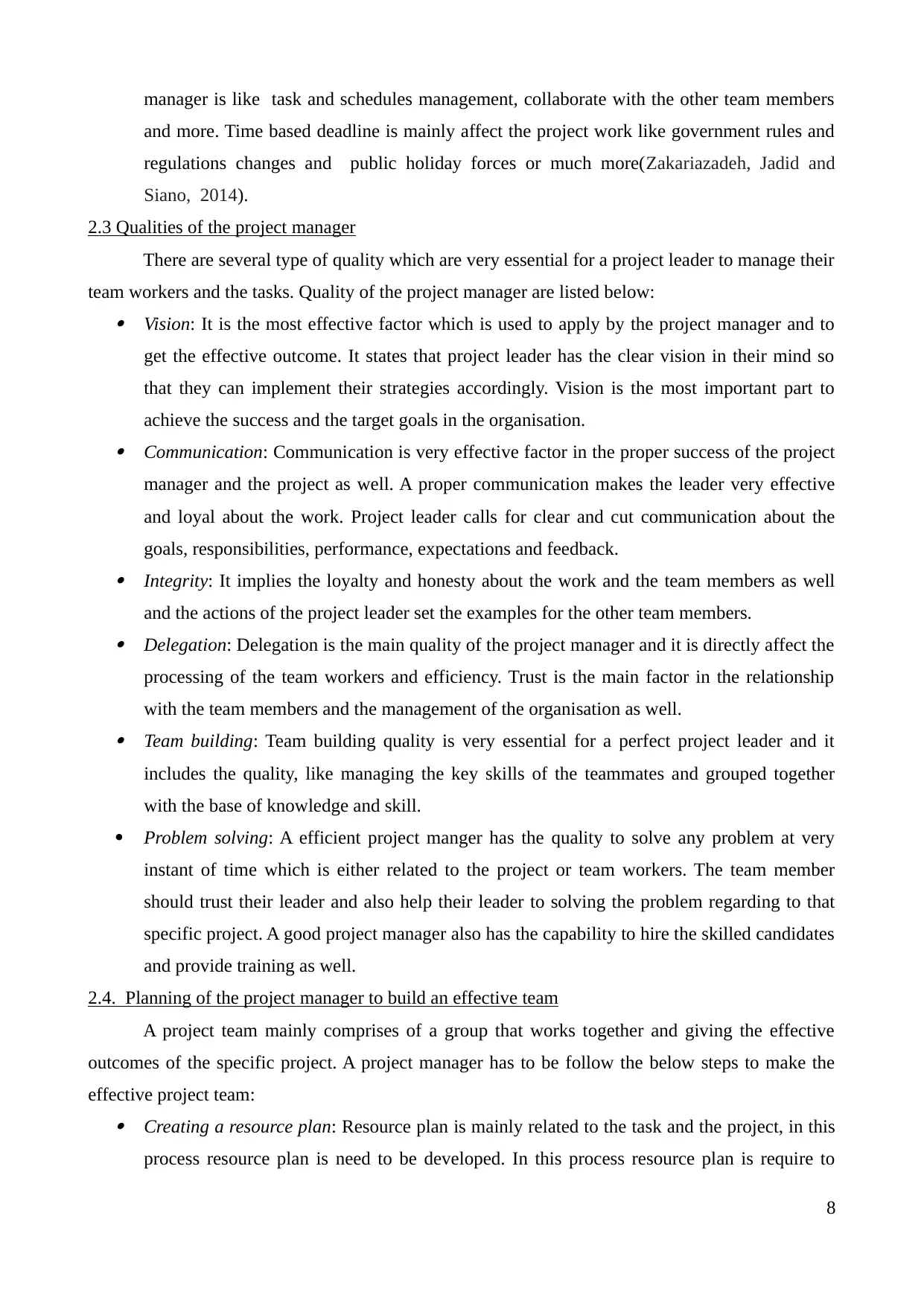
manager is like task and schedules management, collaborate with the other team members
and more. Time based deadline is mainly affect the project work like government rules and
regulations changes and public holiday forces or much more(Zakariazadeh, Jadid and
Siano, 2014).
2.3 Qualities of the project manager
There are several type of quality which are very essential for a project leader to manage their
team workers and the tasks. Quality of the project manager are listed below: Vision: It is the most effective factor which is used to apply by the project manager and to
get the effective outcome. It states that project leader has the clear vision in their mind so
that they can implement their strategies accordingly. Vision is the most important part to
achieve the success and the target goals in the organisation. Communication: Communication is very effective factor in the proper success of the project
manager and the project as well. A proper communication makes the leader very effective
and loyal about the work. Project leader calls for clear and cut communication about the
goals, responsibilities, performance, expectations and feedback. Integrity: It implies the loyalty and honesty about the work and the team members as well
and the actions of the project leader set the examples for the other team members. Delegation: Delegation is the main quality of the project manager and it is directly affect the
processing of the team workers and efficiency. Trust is the main factor in the relationship
with the team members and the management of the organisation as well. Team building: Team building quality is very essential for a perfect project leader and it
includes the quality, like managing the key skills of the teammates and grouped together
with the base of knowledge and skill.
Problem solving: A efficient project manger has the quality to solve any problem at very
instant of time which is either related to the project or team workers. The team member
should trust their leader and also help their leader to solving the problem regarding to that
specific project. A good project manager also has the capability to hire the skilled candidates
and provide training as well.
2.4. Planning of the project manager to build an effective team
A project team mainly comprises of a group that works together and giving the effective
outcomes of the specific project. A project manager has to be follow the below steps to make the
effective project team: Creating a resource plan: Resource plan is mainly related to the task and the project, in this
process resource plan is need to be developed. In this process resource plan is require to
8
and more. Time based deadline is mainly affect the project work like government rules and
regulations changes and public holiday forces or much more(Zakariazadeh, Jadid and
Siano, 2014).
2.3 Qualities of the project manager
There are several type of quality which are very essential for a project leader to manage their
team workers and the tasks. Quality of the project manager are listed below: Vision: It is the most effective factor which is used to apply by the project manager and to
get the effective outcome. It states that project leader has the clear vision in their mind so
that they can implement their strategies accordingly. Vision is the most important part to
achieve the success and the target goals in the organisation. Communication: Communication is very effective factor in the proper success of the project
manager and the project as well. A proper communication makes the leader very effective
and loyal about the work. Project leader calls for clear and cut communication about the
goals, responsibilities, performance, expectations and feedback. Integrity: It implies the loyalty and honesty about the work and the team members as well
and the actions of the project leader set the examples for the other team members. Delegation: Delegation is the main quality of the project manager and it is directly affect the
processing of the team workers and efficiency. Trust is the main factor in the relationship
with the team members and the management of the organisation as well. Team building: Team building quality is very essential for a perfect project leader and it
includes the quality, like managing the key skills of the teammates and grouped together
with the base of knowledge and skill.
Problem solving: A efficient project manger has the quality to solve any problem at very
instant of time which is either related to the project or team workers. The team member
should trust their leader and also help their leader to solving the problem regarding to that
specific project. A good project manager also has the capability to hire the skilled candidates
and provide training as well.
2.4. Planning of the project manager to build an effective team
A project team mainly comprises of a group that works together and giving the effective
outcomes of the specific project. A project manager has to be follow the below steps to make the
effective project team: Creating a resource plan: Resource plan is mainly related to the task and the project, in this
process resource plan is need to be developed. In this process resource plan is require to
8
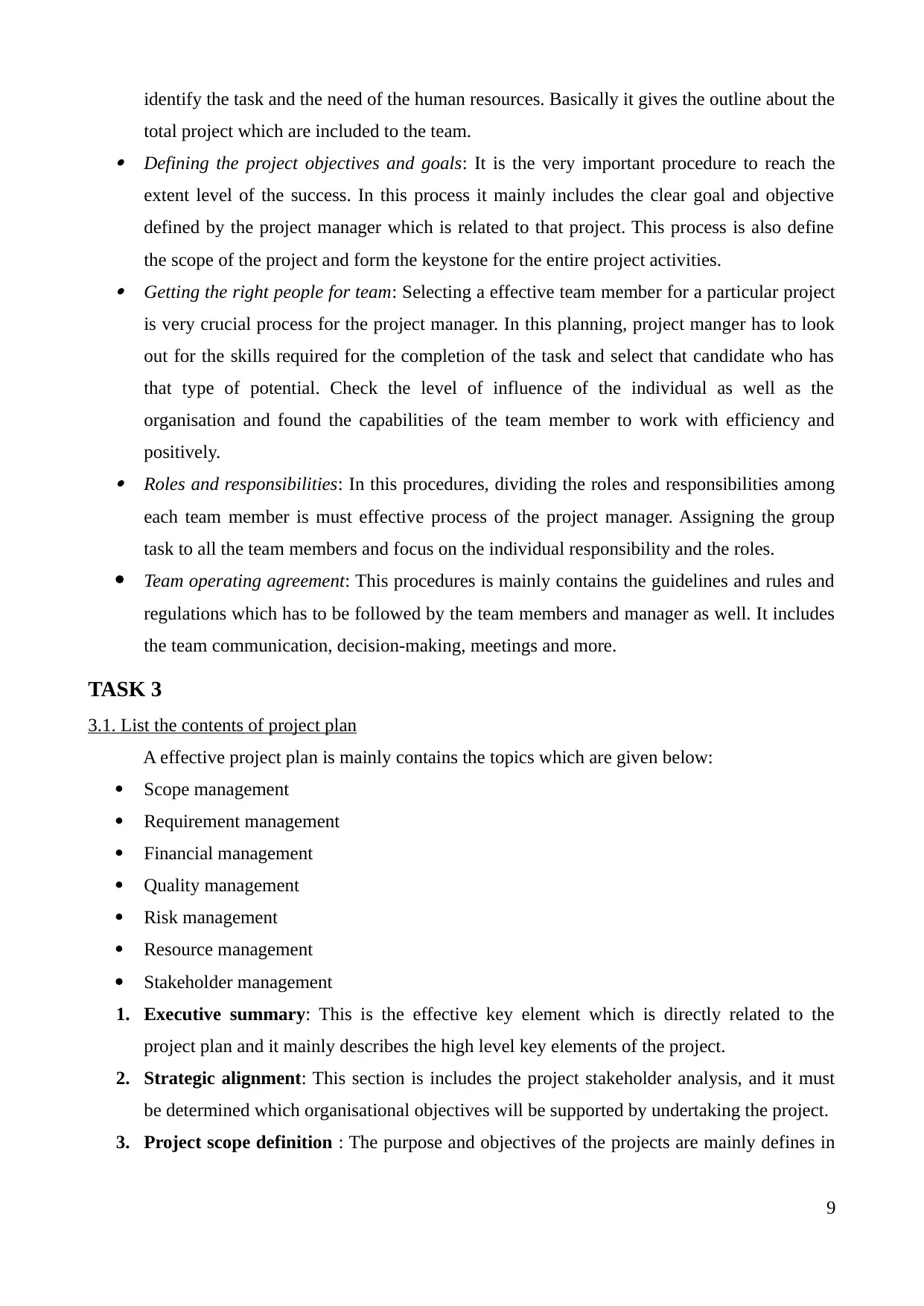
identify the task and the need of the human resources. Basically it gives the outline about the
total project which are included to the team. Defining the project objectives and goals: It is the very important procedure to reach the
extent level of the success. In this process it mainly includes the clear goal and objective
defined by the project manager which is related to that project. This process is also define
the scope of the project and form the keystone for the entire project activities. Getting the right people for team: Selecting a effective team member for a particular project
is very crucial process for the project manager. In this planning, project manger has to look
out for the skills required for the completion of the task and select that candidate who has
that type of potential. Check the level of influence of the individual as well as the
organisation and found the capabilities of the team member to work with efficiency and
positively. Roles and responsibilities: In this procedures, dividing the roles and responsibilities among
each team member is must effective process of the project manager. Assigning the group
task to all the team members and focus on the individual responsibility and the roles.
Team operating agreement: This procedures is mainly contains the guidelines and rules and
regulations which has to be followed by the team members and manager as well. It includes
the team communication, decision-making, meetings and more.
TASK 3
3.1. List the contents of project plan
A effective project plan is mainly contains the topics which are given below:
Scope management
Requirement management
Financial management
Quality management
Risk management
Resource management
Stakeholder management
1. Executive summary: This is the effective key element which is directly related to the
project plan and it mainly describes the high level key elements of the project.
2. Strategic alignment: This section is includes the project stakeholder analysis, and it must
be determined which organisational objectives will be supported by undertaking the project.
3. Project scope definition : The purpose and objectives of the projects are mainly defines in
9
total project which are included to the team. Defining the project objectives and goals: It is the very important procedure to reach the
extent level of the success. In this process it mainly includes the clear goal and objective
defined by the project manager which is related to that project. This process is also define
the scope of the project and form the keystone for the entire project activities. Getting the right people for team: Selecting a effective team member for a particular project
is very crucial process for the project manager. In this planning, project manger has to look
out for the skills required for the completion of the task and select that candidate who has
that type of potential. Check the level of influence of the individual as well as the
organisation and found the capabilities of the team member to work with efficiency and
positively. Roles and responsibilities: In this procedures, dividing the roles and responsibilities among
each team member is must effective process of the project manager. Assigning the group
task to all the team members and focus on the individual responsibility and the roles.
Team operating agreement: This procedures is mainly contains the guidelines and rules and
regulations which has to be followed by the team members and manager as well. It includes
the team communication, decision-making, meetings and more.
TASK 3
3.1. List the contents of project plan
A effective project plan is mainly contains the topics which are given below:
Scope management
Requirement management
Financial management
Quality management
Risk management
Resource management
Stakeholder management
1. Executive summary: This is the effective key element which is directly related to the
project plan and it mainly describes the high level key elements of the project.
2. Strategic alignment: This section is includes the project stakeholder analysis, and it must
be determined which organisational objectives will be supported by undertaking the project.
3. Project scope definition : The purpose and objectives of the projects are mainly defines in
9
⊘ This is a preview!⊘
Do you want full access?
Subscribe today to unlock all pages.

Trusted by 1+ million students worldwide
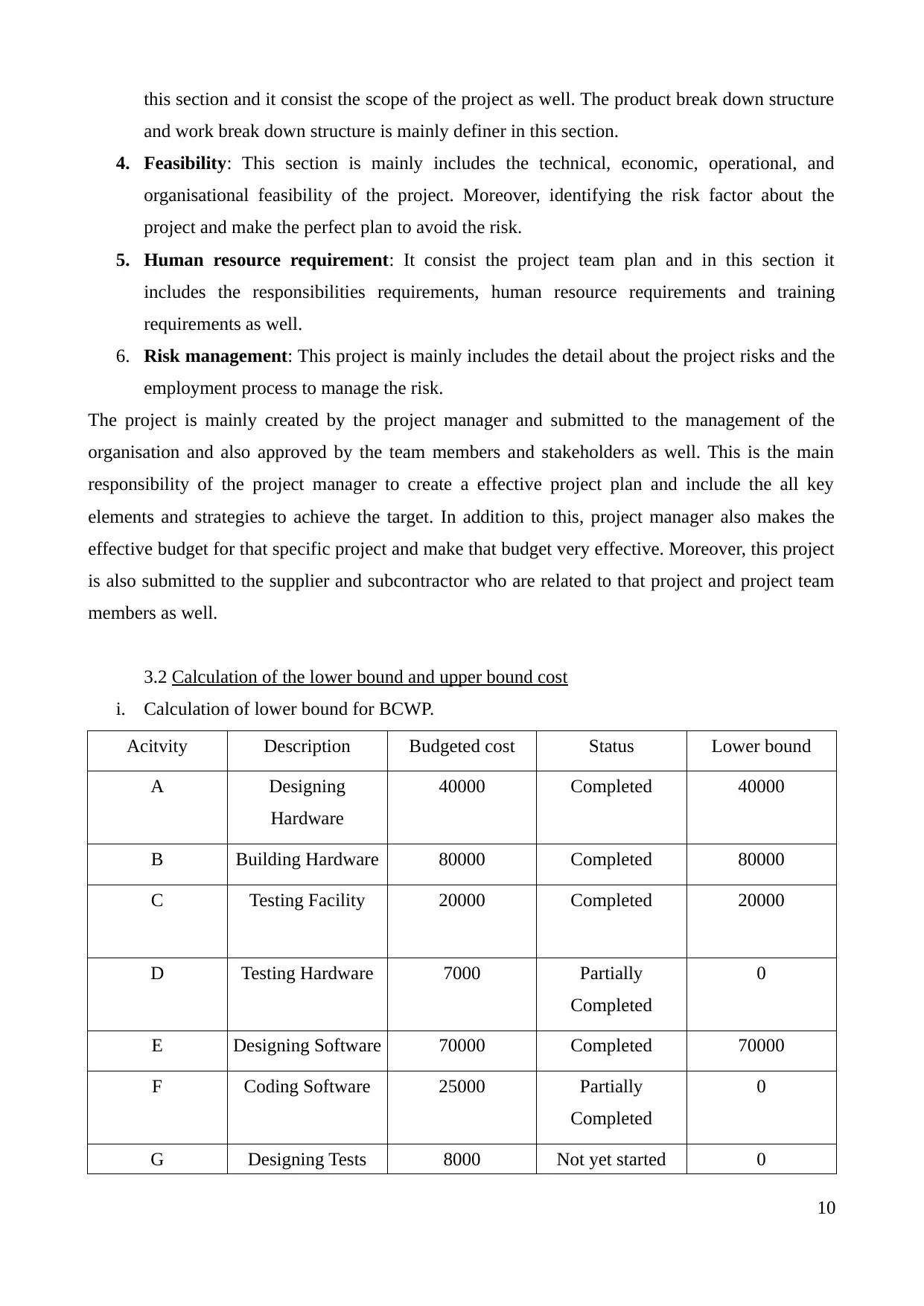
this section and it consist the scope of the project as well. The product break down structure
and work break down structure is mainly definer in this section.
4. Feasibility: This section is mainly includes the technical, economic, operational, and
organisational feasibility of the project. Moreover, identifying the risk factor about the
project and make the perfect plan to avoid the risk.
5. Human resource requirement: It consist the project team plan and in this section it
includes the responsibilities requirements, human resource requirements and training
requirements as well.
6. Risk management: This project is mainly includes the detail about the project risks and the
employment process to manage the risk.
The project is mainly created by the project manager and submitted to the management of the
organisation and also approved by the team members and stakeholders as well. This is the main
responsibility of the project manager to create a effective project plan and include the all key
elements and strategies to achieve the target. In addition to this, project manager also makes the
effective budget for that specific project and make that budget very effective. Moreover, this project
is also submitted to the supplier and subcontractor who are related to that project and project team
members as well.
3.2 Calculation of the lower bound and upper bound cost
i. Calculation of lower bound for BCWP.
Acitvity Description Budgeted cost Status Lower bound
A Designing
Hardware
40000 Completed 40000
B Building Hardware 80000 Completed 80000
C Testing Facility 20000 Completed 20000
D Testing Hardware 7000 Partially
Completed
0
E Designing Software 70000 Completed 70000
F Coding Software 25000 Partially
Completed
0
G Designing Tests 8000 Not yet started 0
10
and work break down structure is mainly definer in this section.
4. Feasibility: This section is mainly includes the technical, economic, operational, and
organisational feasibility of the project. Moreover, identifying the risk factor about the
project and make the perfect plan to avoid the risk.
5. Human resource requirement: It consist the project team plan and in this section it
includes the responsibilities requirements, human resource requirements and training
requirements as well.
6. Risk management: This project is mainly includes the detail about the project risks and the
employment process to manage the risk.
The project is mainly created by the project manager and submitted to the management of the
organisation and also approved by the team members and stakeholders as well. This is the main
responsibility of the project manager to create a effective project plan and include the all key
elements and strategies to achieve the target. In addition to this, project manager also makes the
effective budget for that specific project and make that budget very effective. Moreover, this project
is also submitted to the supplier and subcontractor who are related to that project and project team
members as well.
3.2 Calculation of the lower bound and upper bound cost
i. Calculation of lower bound for BCWP.
Acitvity Description Budgeted cost Status Lower bound
A Designing
Hardware
40000 Completed 40000
B Building Hardware 80000 Completed 80000
C Testing Facility 20000 Completed 20000
D Testing Hardware 7000 Partially
Completed
0
E Designing Software 70000 Completed 70000
F Coding Software 25000 Partially
Completed
0
G Designing Tests 8000 Not yet started 0
10
Paraphrase This Document
Need a fresh take? Get an instant paraphrase of this document with our AI Paraphraser
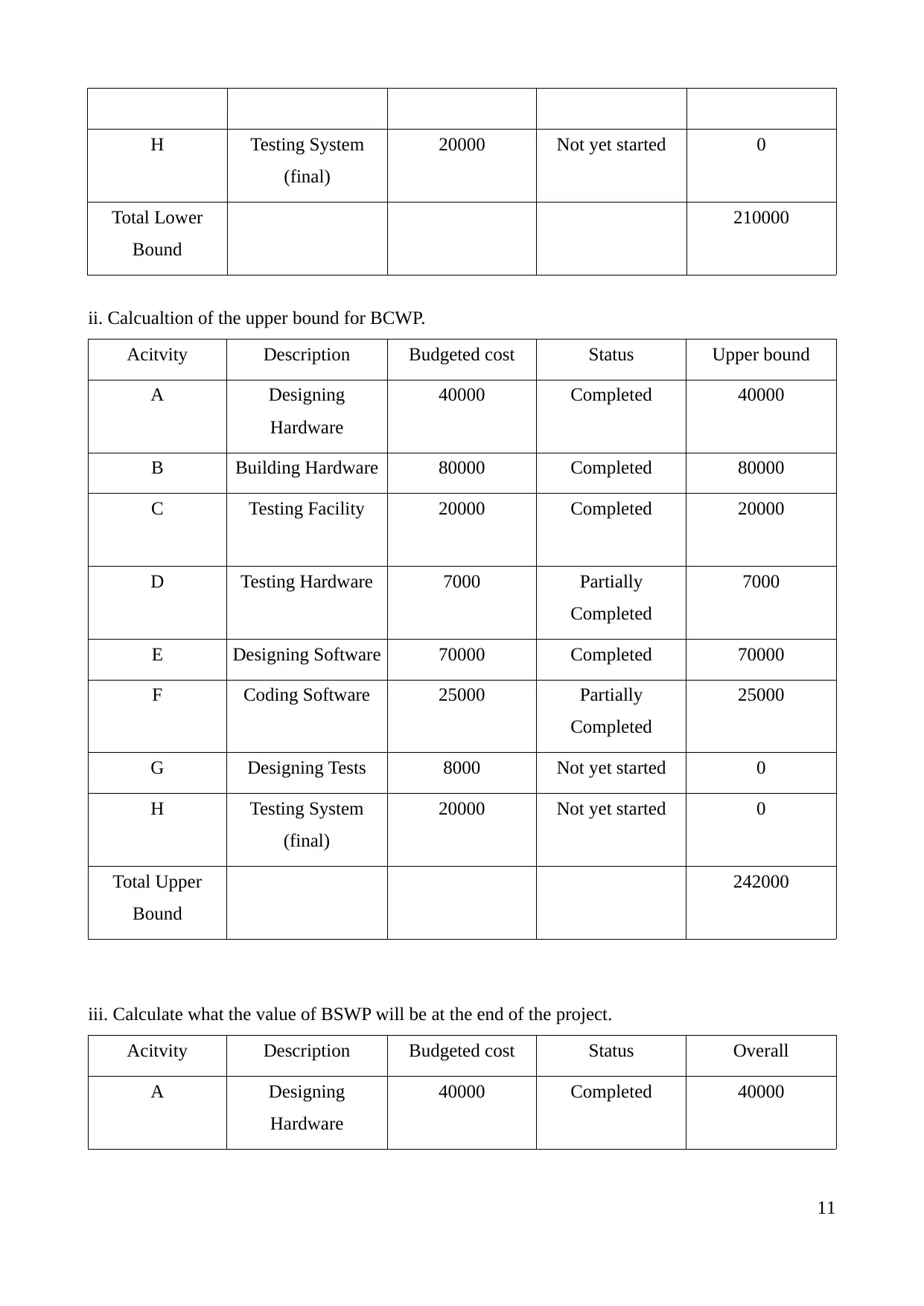
H Testing System
(final)
20000 Not yet started 0
Total Lower
Bound
210000
ii. Calcualtion of the upper bound for BCWP.
Acitvity Description Budgeted cost Status Upper bound
A Designing
Hardware
40000 Completed 40000
B Building Hardware 80000 Completed 80000
C Testing Facility 20000 Completed 20000
D Testing Hardware 7000 Partially
Completed
7000
E Designing Software 70000 Completed 70000
F Coding Software 25000 Partially
Completed
25000
G Designing Tests 8000 Not yet started 0
H Testing System
(final)
20000 Not yet started 0
Total Upper
Bound
242000
iii. Calculate what the value of BSWP will be at the end of the project.
Acitvity Description Budgeted cost Status Overall
A Designing
Hardware
40000 Completed 40000
11
(final)
20000 Not yet started 0
Total Lower
Bound
210000
ii. Calcualtion of the upper bound for BCWP.
Acitvity Description Budgeted cost Status Upper bound
A Designing
Hardware
40000 Completed 40000
B Building Hardware 80000 Completed 80000
C Testing Facility 20000 Completed 20000
D Testing Hardware 7000 Partially
Completed
7000
E Designing Software 70000 Completed 70000
F Coding Software 25000 Partially
Completed
25000
G Designing Tests 8000 Not yet started 0
H Testing System
(final)
20000 Not yet started 0
Total Upper
Bound
242000
iii. Calculate what the value of BSWP will be at the end of the project.
Acitvity Description Budgeted cost Status Overall
A Designing
Hardware
40000 Completed 40000
11
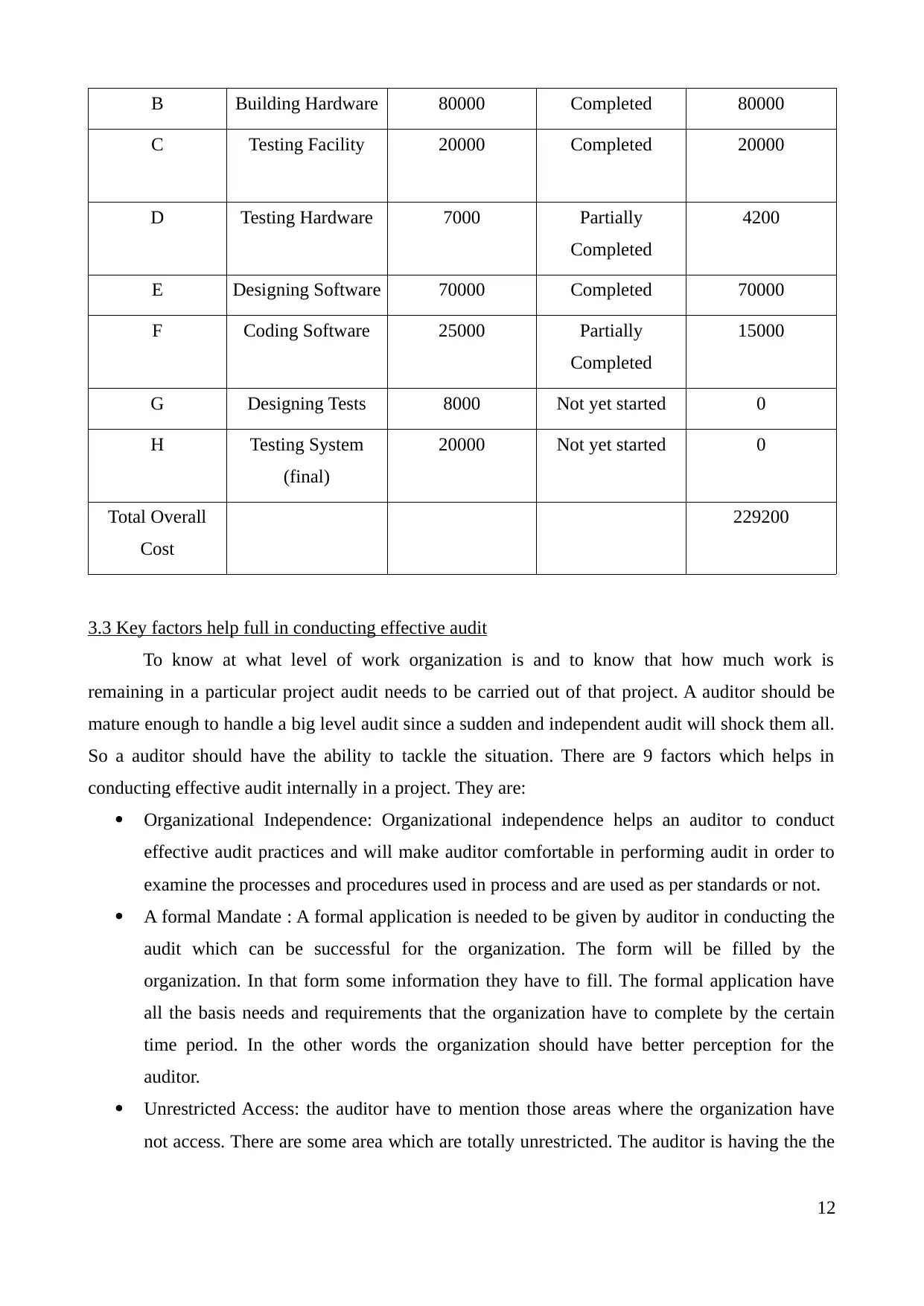
B Building Hardware 80000 Completed 80000
C Testing Facility 20000 Completed 20000
D Testing Hardware 7000 Partially
Completed
4200
E Designing Software 70000 Completed 70000
F Coding Software 25000 Partially
Completed
15000
G Designing Tests 8000 Not yet started 0
H Testing System
(final)
20000 Not yet started 0
Total Overall
Cost
229200
3.3 Key factors help full in conducting effective audit
To know at what level of work organization is and to know that how much work is
remaining in a particular project audit needs to be carried out of that project. A auditor should be
mature enough to handle a big level audit since a sudden and independent audit will shock them all.
So a auditor should have the ability to tackle the situation. There are 9 factors which helps in
conducting effective audit internally in a project. They are:
Organizational Independence: Organizational independence helps an auditor to conduct
effective audit practices and will make auditor comfortable in performing audit in order to
examine the processes and procedures used in process and are used as per standards or not.
A formal Mandate : A formal application is needed to be given by auditor in conducting the
audit which can be successful for the organization. The form will be filled by the
organization. In that form some information they have to fill. The formal application have
all the basis needs and requirements that the organization have to complete by the certain
time period. In the other words the organization should have better perception for the
auditor.
Unrestricted Access: the auditor have to mention those areas where the organization have
not access. There are some area which are totally unrestricted. The auditor is having the the
12
C Testing Facility 20000 Completed 20000
D Testing Hardware 7000 Partially
Completed
4200
E Designing Software 70000 Completed 70000
F Coding Software 25000 Partially
Completed
15000
G Designing Tests 8000 Not yet started 0
H Testing System
(final)
20000 Not yet started 0
Total Overall
Cost
229200
3.3 Key factors help full in conducting effective audit
To know at what level of work organization is and to know that how much work is
remaining in a particular project audit needs to be carried out of that project. A auditor should be
mature enough to handle a big level audit since a sudden and independent audit will shock them all.
So a auditor should have the ability to tackle the situation. There are 9 factors which helps in
conducting effective audit internally in a project. They are:
Organizational Independence: Organizational independence helps an auditor to conduct
effective audit practices and will make auditor comfortable in performing audit in order to
examine the processes and procedures used in process and are used as per standards or not.
A formal Mandate : A formal application is needed to be given by auditor in conducting the
audit which can be successful for the organization. The form will be filled by the
organization. In that form some information they have to fill. The formal application have
all the basis needs and requirements that the organization have to complete by the certain
time period. In the other words the organization should have better perception for the
auditor.
Unrestricted Access: the auditor have to mention those areas where the organization have
not access. There are some area which are totally unrestricted. The auditor is having the the
12
⊘ This is a preview!⊘
Do you want full access?
Subscribe today to unlock all pages.

Trusted by 1+ million students worldwide
1 out of 17
Related Documents
Your All-in-One AI-Powered Toolkit for Academic Success.
+13062052269
info@desklib.com
Available 24*7 on WhatsApp / Email
![[object Object]](/_next/static/media/star-bottom.7253800d.svg)
Unlock your academic potential
Copyright © 2020–2025 A2Z Services. All Rights Reserved. Developed and managed by ZUCOL.





